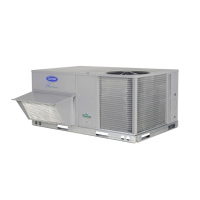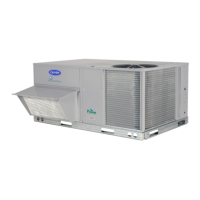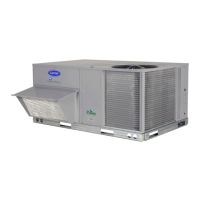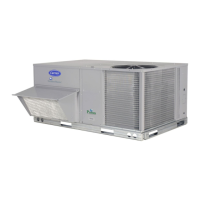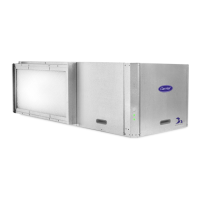MAINTENANCE
To ensure continuing high performance, and to minimize
the possibility of premature equipment failure, periodic main-
tenance must be performed on this equipment. This heat pump
unit should be inspected at least once each year by a quali-
fied service person. To troubleshoot units, refer to
Cooling and Heating Troubleshooting chart in the back of
this book.
NOTE TO EQUIPMENT OWNER: Consult your local dealer
about the availability of a maintenance contract.
The ability to properly perform maintenance on this equip-
ment requires certain expertise, mechanical skills, tools,
and equipment. If you do not possess these, do not at-
tempt to perform any maintenance on this equipment.
FAILURE TO HEED THIS WARNING COULD RE-
SULT IN SERIOUS PERSONAL INJURY AND POS-
SIBLE DAMAGE TO THIS EQUIPMENT.
The minimum maintenance requirements for this equip-
ment are as follows:
1. Inspect air filter(s) each month. Clean or replace when
necessary.
2. Inspect indoor coil, drain pan, and condensate drain each
cooling season for cleanliness. Clean when necessary.
3. Inspect blower motor and wheel for cleanliness and check
lubrication each cooling season. Clean and lubricate when
necessary.
4. Check that electrical connections are tight and check con-
trols for proper operation each cooling season. Service
when necessary.
Failure to follow these warnings could result in serious
personal injury:
1. Turn off electrical power to the unit before perform-
ing any maintenance or service on the unit.
2. Use extreme caution when removing panels and parts.
As with any mechanical equipment, personal injury
can result from sharp edges.
3. Never place anything combustible either on, or in con-
tact with, the unit.
Air Filter
Never operate the unit without a suitable air filter in the
return-air duct system. Always replace the filter with the
same dimensional size and type as originally installed.
See Tables 1A and 1B for recommended filter sizes.
Inspect air filter(s) at least once each month and replace
at least twice during each cooling season or whenever the
filters become clogged with dust and lint.
Replace filters with the same dimensional size and type as
originally provided.
Unit Top Removal
NOTE: When performing maintenance or service proce-
dures that require removal of the unit top, be sure to perform
all of the routine maintenance procedures that require top
removal, including coil and condensate drain pan inspection
and cleaning.
Only qualified service personnel should perform mainte-
nance and service procedures that require unit top removal.
To remove unit top:
1. Remove 7 screws on unit top cover surface. (Save all screws.)
2. Remove 4 screws on unit top cover flange. (Save all screws.)
3. Lift top from unit carefully. Set top on edge and make
sure that top is supported by unit side that is opposite
duct (or plenum) side.
4. Carefully replace and secure unit top to unit (using screws
removed in Steps 1 and 2), when maintenance and/or serv-
ice procedures are completed.
Indoor Blower and Motor
NOTE: Motors without oilers are prelubricated. Do not at-
tempt to lubricate these motors.
For longer life, operating economy, and continuing effi-
ciency, clean accumulated dirt and grease from the blower
wheel and motor annually.
Lubricate the motor every 5 years if the motor is used in-
termittently (thermostat FAN switch in AUTO. position), or
every 2 years if the motor is used continuously (thermostat
FAN switch in ON position).
Disconnect and tag electrical power to the unit before
cleaning and lubricating the blower motor and wheel.
Failure to adhere to this warning could cause personal
injury or death.
To clean and lubricate the blower motor and wheel:
1. Remove and disassemble blower assembly as follows:
a. Remove blower access door.
b. Disconnect motor lead from indoor-fan contactor. Dis-
connect yellow motor lead from terminal L2 or 23 of
the contactor.
c. Remove blower assembly from unit. Be careful not to
tear insulation in blower compartment.
d. Ensure proper reassembly by marking blower wheel
and motor in relation to blower housing before
disassembly.
e. Loosen setscrew(s) which secure wheel to motor shaft.
Remove screws that secure motor mount brackets to
housing and slide motor and motor mount out of
housing.
2. Lubricate motor as follows:
a. Thoroughly clean all accumulations of dirt or grease
from motor housing.
b. Remove dust caps or plugs from oil ports located at
each end of motor.
c. Use a good grade of SAE 20 (Society of Automotive
Engineers, U.S.A.) nondetergent motor oil and put
5 cc (1 teaspoon,
3
⁄
16
oz, or 16 to 25 drops) in each oil
port.
d. Allow time for oil to be absorbed by each bearing,
then wipe excess oil from motor housing.
e. Replace dust caps or plugs in oil ports.
3. Remove and clean blower wheel as follows:
a. Ensure proper reassembly by marking wheel orienta-
tion and cutoff plate location.
b. Remove screws holding cut-off plate, and remove plate
from housing.
20

